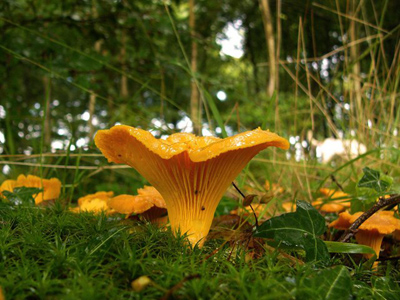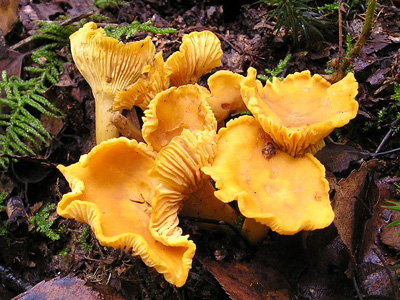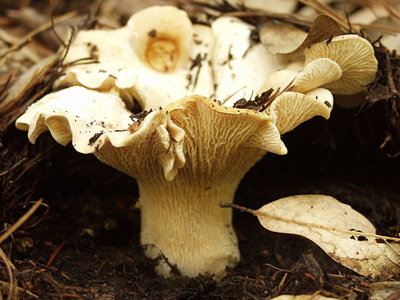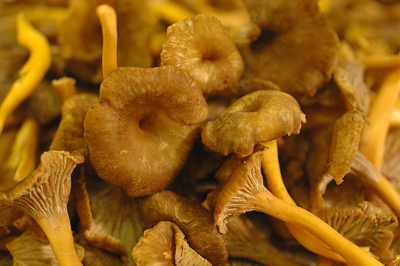Chantrelle Mushrooms:
Gifts of the Forest

Chantrelle mushrooms – which are also called “chanterelles” – are one of the most harvested and most widely enjoyed wild mushrooms in the world. There are a variety of species belonging to this group of mushrooms, known as the Cantharellaceae. Some of the species in this group are delicious wild edibles and very much worth getting to know.
Why Chanterelles?
These mushrooms are known around the world for their unique flavors and meaty texture. Also, these mushrooms cannot be cultivated, and must be harvested from the wild. For some mushroom eaters, this adds to their appeal. Chantrelle mushrooms also tend to be relatively clean and bug-free when harvested, and also store well when frozen or dried.
What do they look like?
Recognizing this group of mushrooms takes close inspection and an understanding of mushroom parts. The several species that will be discussed all include the following features:
- Cap has a depressed or concave center.
- Cap edge wavy or rounded.
- Gills are blunt, ridge-like or vein-like and grow part way down the stalk.
- Gill pattern is like a lightning bolt branching upwards
- Grow on the ground in woodlands or forests
Which species are best?
Although this is some-what subjective, the following are a few of the highly popular and sought after species.

Golden Chanterelles
This species is now known to be a complex of several similar looking species. The species Cantharellus cibarius is the most famous, and is found in many parts of Europe. It may not actually be present in North America. Several similar species, however, are found in the United States, including Cantharellus cascadensis, Cantharellus formosus, Cantharellus californicus and Cantharellus cibarius var. roseocanus. All share a golden-yellow appearance, and are equally edible. The flesh of these tends to be white when cut.

White Chanterelle
This species of chantrelle mushroom - Cantharellus subalbidus
– is large, meaty and very pale.
Generally the color of this species is off-white to pure white. This species is found in older, mature
forests and also, found in old-growth forests.
The flesh is white when cut.

Trumpet Chanterelle or Yellow-Foot Chanterelle
This species – Cantharellus tubaeformis – is small, with a hollow chamber most of the way or all the way through the stalk. It can grow in great abundance under the right conditions on the forest floor. Flesh of this species tends to be pale yellow to pale brownish and is fairly flimsy compared to the more solid stemmed species mentioned previously.
Be More Prepared For Your Next Outdoor Adventure!

Don't leave home without knowing these six essential survival skills. Our free survival mini guide reveals the strategies of:
- Shelter & fire to prevent the number one cause of death
- Obtaining clean water to avoid life-threatening dehydration
- Common wild survival foods and other critical skills!

How to preserve or prepare chantrelle mushrooms?
There are many ways to cook chantrelle mushrooms, but perhaps one of the best is the dry-sauté method. This method involves cutting the cleaned and sliced mushrooms in a pan on low to medium-low heat for a few minutes. They must be closely attended to and stirred frequently as they can quickly stick to the pan. The idea is to cook out some of the water out of the mushrooms before you add oil or butter to finish cooking them. Once you have reached a point where much of the water has cooked out, add your oil or butter and cook them for another few minutes on the same heat. Then they can be added to various dishes, or cooled and stored in this state in the freezer until needed.
The other method to process these mushrooms is to dry them. This is best done gradually in a food dehydrator on low heat. If they are dried to quickly, this group of mushrooms tends to lose much of its flavor.
Closing Thoughts
If you are not familiar with this group of mushrooms yet, I would highly recommend getting to know them. They are delicious, high in vitamin D and protein, and are a delightful part of the fall bounty in our forests and woodlands.
Please use caution when eating any mushrooms your are not familiar with, and consider taking a class on mushrooms as well as acquiring some quality field guides.
Go out to your local woods and meet them this fall!
By the way, when you're out foraging for wild plants and mushrooms, it's important to know how to stay safe in the outdoors, especially if you were to get lost. Right now you can get a free copy of our mini survival guide here, where you'll discover six key strategies for outdoor emergencies, plus often-overlooked survival tips.
Resources:
Books:
Mushrooms Demystified by David Arora
All That the Rain Promises by David Arora
100 Edible Mushrooms by Michael Kuo
Articles:
Checkout this article about Chantrelles by Michael Kuo from MushroomExpert.com
Related Courses:
Wild Mushroom Identification Class

About the Author: Filip Tkaczyk is a periodic guest teacher at Alderleaf. He also wrote the field guide Tracks & Sign of Reptiles & Amphibians. Learn more about Filip Tkaczyk.
Return from Chantrelle Mushrooms back to Wild Plants Articles
Is The Essential Wilderness Survival Skills Course Right for You? Take the "Online Survival Training Readiness" Quiz
See for yourself if this eye-opening course is a good fit for you. It takes just a few minutes! Get your Survival Training Readiness Score Now!

Grow Your Outdoor Skills! Get monthly updates on new wilderness skills, upcoming courses, and special opportunities. Join the free Alderleaf eNews and as a welcome gift you'll get a copy of our Mini Survival Guide.

 The Six Keys to Survival: Get a free copy of our survival mini-guide and monthly tips!
The Six Keys to Survival: Get a free copy of our survival mini-guide and monthly tips!
Learn more